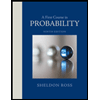
A First Course in Probability (10th Edition)
10th Edition
ISBN: 9780134753119
Author: Sheldon Ross
Publisher: PEARSON
expand_more
expand_more
format_list_bulleted
Question
![. The probability that two specified letters will be placed in the correct envelopes is 1[n(n – 1)]. The
probability that none of the othern – 2 letters will then be placed in the correct envelopes is qn-2.
Therefore, the probability that only the two specified letters, and no other letters, will be placed
in the correct envelopes is
1
-¶n-2. It follows that the probability that exactly two of the n
п(п — 1)
letters will be placed in the correct envelopes, without specifying which pair will be correctly placed,](https://content.bartleby.com/qna-images/question/8b0050e1-8a86-497b-9cc6-b844a5887701/b0f48d32-d6e8-4cce-9f39-f684fd591255/0v54w8k_thumbnail.jpeg)
Transcribed Image Text:. The probability that two specified letters will be placed in the correct envelopes is 1[n(n – 1)]. The
probability that none of the othern – 2 letters will then be placed in the correct envelopes is qn-2.
Therefore, the probability that only the two specified letters, and no other letters, will be placed
in the correct envelopes is
1
-¶n-2. It follows that the probability that exactly two of the n
п(п — 1)
letters will be placed in the correct envelopes, without specifying which pair will be correctly placed,
Expert Solution
This question has been solved!
Explore an expertly crafted, step-by-step solution for a thorough understanding of key concepts.
Step by stepSolved in 2 steps with 2 images

Knowledge Booster
Similar questions
- Suppose that in a certain large population, the proportion of people that have blood type O is 0.33. If 7 people are randomly and independently selected from this population, what is the probability that no more than one has blood type O? (Give your response to at least 3 decimal places. Give only your numeric response, and not any extra characters or symbols.) Your Answer:arrow_forwardComputers A and B can independently generate positive integers: • Computer A generates positive integer n with probability a/3", where a is a constant. • Computer B generates positive integer n with probability 3/n!, where ß is a constant. (a) Find the probability that the number generated by A is larger than the number generated by B. (b) Find the probability that the number generated by A is smaller than the number generated by B.arrow_forwardEach of the numbers 0 - 9 is written on a sheet of paper and the ten sheets of paper are placed in a box If two of these sheets of paper are selected from the box at random, without replacement, find the probability that both numbers are greater than 7.arrow_forward
- Bianca has two coins. Coin A is a biased coin that comes up HEAD with probability 0.3. Coin B is a fair coin that comes up HEAD with probability 0.5. Bianca picks one of the two coins uniformly at random. She flips it. Conditioned on that the outcome of the coin flip is HEAD, what is the probability that Bianca picked coin A? Give the answer as an irreducible fraction of two integers.arrow_forward. Assume that the box contains balls numbered from 1 through 28, and that 3 are selected. A random variable X is defined as 3 times the number of odd balls selected, plus 4 times the number of even. How many different values are possible for the random variable X?arrow_forwardSuppose a quiz consists of 9 true-false questions and A is the event that all 9 questions are answered the same way (all true or all false). How many elements are in the complement of A?n(A´) =arrow_forward
arrow_back_ios
arrow_forward_ios
Recommended textbooks for you
 A First Course in Probability (10th Edition)ProbabilityISBN:9780134753119Author:Sheldon RossPublisher:PEARSON
A First Course in Probability (10th Edition)ProbabilityISBN:9780134753119Author:Sheldon RossPublisher:PEARSON

A First Course in Probability (10th Edition)
Probability
ISBN:9780134753119
Author:Sheldon Ross
Publisher:PEARSON
